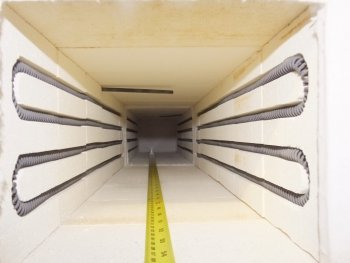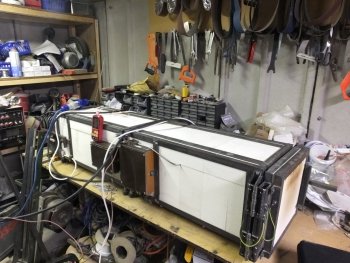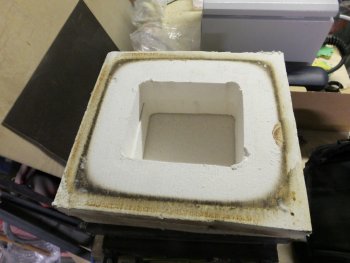Emtore, feel free to shoot any math questions my way, I can more than likely help.
Thanks for that.
I've been gathering formulas and methods from a couple of places, and if you have time to go through it I will calculate a heating element.
You can go over it if you feel like it.
Note: This post will be edited as I find calculation errors.
All measurments are in cm and all results are in cm,
cm ² and watts unless stated otherwise.
First I decide upon the size of the oven chamber.
length=44cm
height=12.5 cm
width=13cm
Calculate chamber area =
2569 cm ²
A sidenote:
This method uses two parameters called surface loading and power density.
Both are measured in Watts per cm ².
Power density applies to the chamber,-surface loading applies to the wire in the heating element(s).
So, what people usually refer to as surface loading at this stage of the calculation, I will be refering to as power density.
We'll need to know how powerful to make our oven, but first let's decide upon a suitable power density value.
The preferred value will be somehere between 0.8 and 1.0. Lower than this, and the oven will take a long time to reach desired temp.
To high, and the temp. will overshoot, and the PDI will struggle to keep temp. stable.
So, let's continue calculating the power of the element with a desired power density of 0.8.
P(watts) = surface area x power density = 2569
cm ² X 0.8 = 2055 watts.
Let's round this up to 2500 watts.
P=2500W
Calculate how much resistance the element(s) has to have.
R=V²/ P
R=230²/ 2500 = 21.16 ohms.
How long does the wire have to be to get a resistance of 21.16 ohms?
1.6 mm wire = 0.695 ohms per meter.
Length of wire (meters) = required wire resistance (ohms) / resistance per meter (ohms) = 21.16 / 0.695 = 30.44 meters.
Surface Loading:
To calculate surface loading we need to first calculate surface area of the wire.
What is the surface area of our wire?
Our wire has a diameter of 1.6 mm which equals 0.16 cm.
Length of wire = 30.44 meters which equals 3044 cm.
Then we calculate the circumference of the wire.
Circumference = π x diameter = 3.14 x 0.16 = 0.5026 centimeters.
Surface area of wire wire length x wire circumference = 3044 x 0.544 = 1530 cm ².
Surface loading = Power / wire surface area = 2500 / 1530 = 1.6 watts per cm ². (Surface loading is twice the desired value. Change wire length and/or diameter and recalculate.)
How long will our 30.44 meter wire become when coiled up tightly?
d = wire diam. (mm)
D = inside coil diam. (mm)
L = length of wire (meters)
x = length of close wound coil (mm)
Inside coil diam. must be at least 5-7 times wire diam. Let's go for 8 times = 12.8 mm. rounded up to 13 mm.
x = L x d x 1000 / π x (D+d)
x = 30.44 x 1.6 x 1000 / 3.14 x (13 + 1.6) = 1063 mm = 1.063 meters, rounded down to 1.0 meters.
The distance between the single windings should be 2-3 times the wire diameter.
For a wire with a diam. of 1.6 mm. this means the distance between windings should be between 3.2 and 4.8 mm.
Stretch the coil at least 2 times the length of the coil when it is tightly wound and see how the distance between windings end up.
Stretch more if distance between windings is below 3.2 mm.
How much you stretch the coil will always be a compromize between distance between windings and length.
If the oven needs a longer element, then stretch some more.
If the element becomes too long and the distance betwen windings is still below 3.2 mm. then cut off some of the wire, provided you don't cut off too much.




